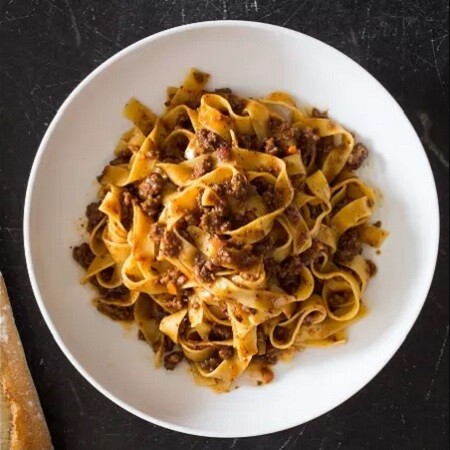Weekend Recipe: Tagliatelle with Bolognese Sauce

To create a quick Bolognese sauce that would rival the depth and richness of a long-cooked version, Cook's Illustrated started by browning the aromatic vegetables (but not the ground beef, which would dry out and toughen if seared) to develop a flavorful fond. We also treated the ground beef with a baking soda solution to ensure that it stayed tender. Adding pancetta, which we ground and browned deeply with the aromatic vegetables, boosted the sauce’s meaty flavor, and a healthy dose of tomato paste added depth and brightness without much acid or overwhelming tomato flavor. We also added Parmesan cheese, usually reserved for serving, directly to the sauce as it cooked for its umami richness. To develop concentrated flavor and a consistency that nicely coated the pasta, we boiled beef broth until it was reduced by half (mixing up a concentrated beef broth using our recommended product, Better Than Bouillon Beef Base, also works) and added it to the sauce, which then needed to simmer only 30 minutes longer. Finally, we intentionally made the sauce thin because the eggy noodles (traditionally tagliatelle or pappardelle) absorb a lot of liquid; once they have soaked up some of the sauce, it will coat the noodles beautifully.
Tagliatelle with Bolognese Sauce
Serves 4 to 6
INGREDIENTS
1 pound 93 percent lean ground beef
2 tablespoons water
¼ teaspoon baking soda
Salt and pepper
4 cups beef broth
6 ounces pancetta, chopped coarse
1 onion, chopped coarse
1 large carrot, peeled and chopped coarse
1 celery rib, chopped coarse
1 tablespoon unsalted butter
1 tablespoon extra-virgin olive oil
3 tablespoons tomato paste
1 cup dry red wine
1 ounce Parmesan cheese, grated (½ cup), plus extra for serving
1 pound tagliatelle
INSTRUCTIONS
If you use our recommended beef broth, Better Than Bouillon Roasted Beef Base, you can skip step 2 and make a concentrated broth by adding 4 teaspoons paste to 2 cups water. To ensure the best flavor, be sure to brown the pancetta-vegetable mixture in step 4 until the fond on the bottom of the pot is quite dark. The cooked sauce will look thin but will thicken once tossed with the pasta. Tagliatelle is a long, flat, dry egg pasta that is about 1/4 inch wide; if you can’t find it, you can substitute pappardelle. Substituting other pasta may result in a too-wet sauce.
1. Toss beef with water, baking soda, and 1/4 teaspoon pepper in bowl until thoroughly combined. Set aside.
2. While beef sits, bring broth to boil over high heat in large pot (this pot will be used to cook pasta in step 6) and cook until reduced to 2 cups, about 15 minutes; set aside.
3. Pulse pancetta in food processor until finely chopped, 15 to 20 pulses. Add onion, carrot, and celery and pulse until vegetables are finely chopped and mixture has paste-like consistency, 12 to 15 pulses, scraping down sides of bowl as needed.
4. Heat butter and oil in large Dutch oven over medium-high heat until shimmering. When foaming subsides, add pancetta-vegetable mixture and 1/4 teaspoon pepper and cook, stirring occasionally, until liquid has evaporated, about 8 minutes. Spread mixture in even layer in bottom of pot and continue to cook, stirring every couple of minutes, until very dark browned bits form on bottom of pot, 7 to 12 minutes longer. Stir in tomato paste and cook until paste is rust-colored and bottom of pot is dark brown, 1 to 2 minutes.
5. Reduce heat to medium, add beef, and cook, using wooden spoon to break meat into pieces no larger than 1/4 inch, until beef has just lost its raw pink color, 4 to 7 minutes. Stir in wine, scraping up any browned bits, and bring to simmer. Cook until wine has evaporated and sauce has thickened, about 5 minutes. Stir in broth and Parmesan. Return sauce to simmer; cover, reduce heat to low, and simmer for 30 minutes (sauce will look thin). Remove from heat and season with salt and pepper to taste.
6. Rinse pot that held broth. While sauce simmers, bring 4 quarts water to boil in now-empty pot. Add pasta and 1 tablespoon salt and cook, stirring occasionally, until al dente. Reserve 1/4 cup cooking water, then drain pasta. Add pasta to pot with sauce and toss to combine. Adjust sauce consistency with reserved cooking water as needed. Transfer to platter or individual bowls and serve, passing extra Parmesan separately.
Want recipes and food news emailed directly to you? Sign up for the Food newsletter here!


